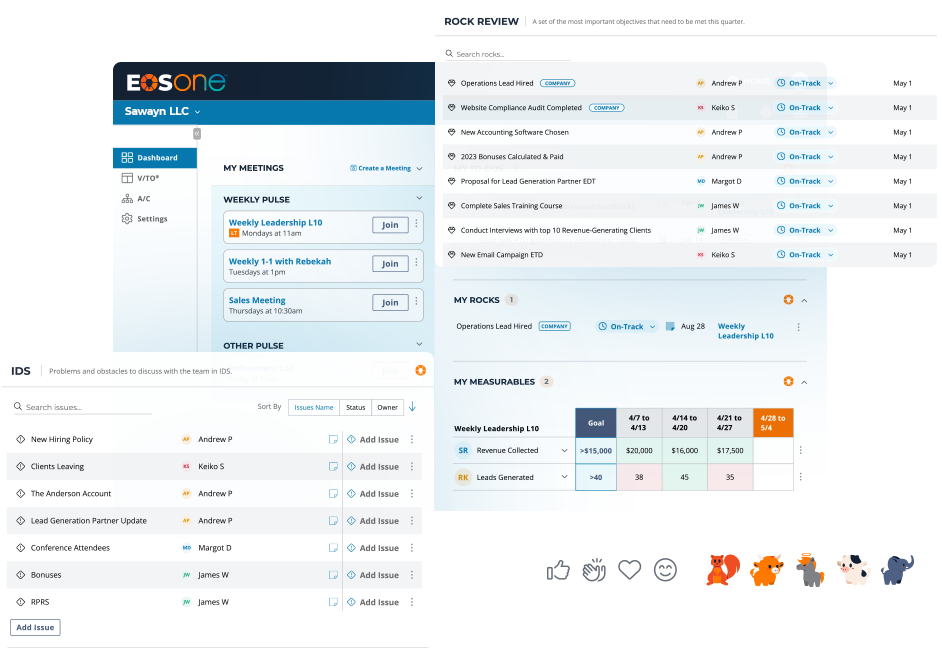Consistent solving and moving through issues are some of the most difficult challenges entrepreneurs face. It’s not surprising that most find it challenging and frustrating. It takes focus, discipline and a solid methodology to get it right.
Here’s where many entrepreneurs get tripped up:
#1. They don’t clearly identify the root issue. The issue produces so many pain points that they don’t know how to dig deep and identify what the real issue is.
#2. They don’t recognize big issues are made up of smaller ones. Issues might have several sub-parts or smaller issues embedded in them.
#3. They dive into unproductive discussion. Their discussion comes from a place of frustration, opinion and emotion, and it’s harder to step back and see what the real issue is.
Setting the Stage for Success
EOS covers the IDS methodology (Identify, Discuss and Solve). This is the methodology that will keep you focused and on track.
Let’s follow a client example through EOS’s IDS process.
Case Study Example
One of my clients was frustrated with the performance of the cybersecurity portion of their business. They addressed the issue in a Level-10 meeting that I was observing.
Step 1: Identify
Their first step was to identify the root issue.
The leadership team discussed the problem and one team member stated the problem as “Our security business is stagnant and losing steam.”
I probed a bit and it was agreed this was a symptom of the issue, but not the root issue. Then, one of the members proceeded to ask a series of questions to dig deeper: “Why do we think this is stagnant?” “Do we have the right person running cybersecurity?” “What does our cybersecurity business really need to reach full potential?”
This is an example of unpacking an issue that contains many sub-parts. Sometimes it’s not possible to solve a big issue during one meeting. That’s okay. But you can break it down into smaller issues and solve them one at a time.
They knew they had an issue with cybersecurity, but they also knew the head of cybersecurity (Jim) had not been performing well. He was a hard-working employee, but they weren’t sure he was in the right seat.
They had to pick one issue to solve first. They chose the “seat” issue and put all the other issues and components on the Issues List to address at a later time.
Step 2: Discuss
The leadership team discussed the expectations of the person leading cybersecurity.
They asked questions like, “What skillset do we need the person in this seat to have to be a success?” “Does Jim possess the skills necessary for this seat?” “If he is not the right person for this seat, what expectations should we have for this position – are we clear enough?” and “What are the challenges around recruiting someone with these skills?”
Through their discussion, they decided that Jim did not have the skills needed to be a success in that seat. Finding the right seat in the company for Jim was a separate issue they added to the Issues List.
Step 3: Solve
The leadership team put together a series of action steps to solve the issue and find the right person for the head of cybersecurity.
- They made a plan to update the seat’s job description.
- They determined if there were internal applicants who would qualify for the seat.
- They discussed how they would advertise the open position and recruit candidates from outside the organization.
By drilling down, asking questions and being focused on the root cause, they were able to identify one issue and make a plan to solve it. They continued this practice with all the separate issues on the Issues List, and over time, cybersecurity was no longer a concern.
Here are a few things to keep in mind as you use IDS to solve your company’s issues:
- Make sure you are discussing the issue, not the symptom. The pain is a symptom of the issue. Don’t get caught up in dialog that doesn’t address the reason for the pain. Recognize that the more familiar a leadership team is with the pain, the harder it is to solve the issue.
- Break issues down into manageable pieces. It’s important to recognize that the BIG issues are usually a series of separate sub-issues that need to be unpacked.
- When you get to the root issue, you have clarity. It’s easier to determine what input is required to solve the issue.
- Stay focused. When you get good at clearly identifying the issue, you know when you’re getting off track.
How are you solving issues in your company? What parts of these struggles can you relate to?


